Teaching Vocabulary with Digital Tools
I once wrangled llamas at a ranch in Colorado. I went to Colorado not knowing much about llamas. I had rental horse experience and basic Girl Scout badges. As teachers we learn much from our students, and so it was on Rocky Mountain trails with the llamas.
On the trail I learned to pack what you need but travel light. Llamas can carry seventy pounds each. We used llamas to carry our gear into the wilderness where we would set up camp. I learned to pack just what we needed to cook, camp with tents and keep warm.
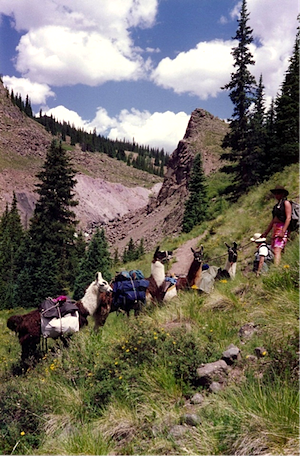 In the classroom, packing purposefully means that I don’t give everything to students at one time. Too much stuff — too many vocabulary words, a packet of worksheets, a plethora of shallow practice material — distracts and bogs learners down.
In the classroom, packing purposefully means that I don’t give everything to students at one time. Too much stuff — too many vocabulary words, a packet of worksheets, a plethora of shallow practice material — distracts and bogs learners down.
Versatile tools
On the trail, multi-purpose tools are handy. A tool like The Max converts from axe, to shovel, to rake, to pick, and more; each mounts on the single handle. In the classroom, we use digital tools that have multiple functions or purposes to study vocabulary. For word learning, free apps and online tools do more and do it differently than flashcards or other traditional word learning activities. Quizlet and Vocabulary.com are two such tools.
This week my students have been gathering words from our whole-class text and learning them using Vocabulary.com, where I’ve been experimenting with list making. I make a master list of more than enough words from a text we are reading together—this week it was Tartuffe. Then I send students to the list to choose words to study.
Students choose 10 words or so every two weeks. They record the words in their academic journals. They print out definitions, synonyms, antonyms and example sentences and glue them in their academic journals. Then they add their own images and later notes to begin building connections to the words. They are building word resource and word reference sections in their journals and each one is different. (Click to enlarge)
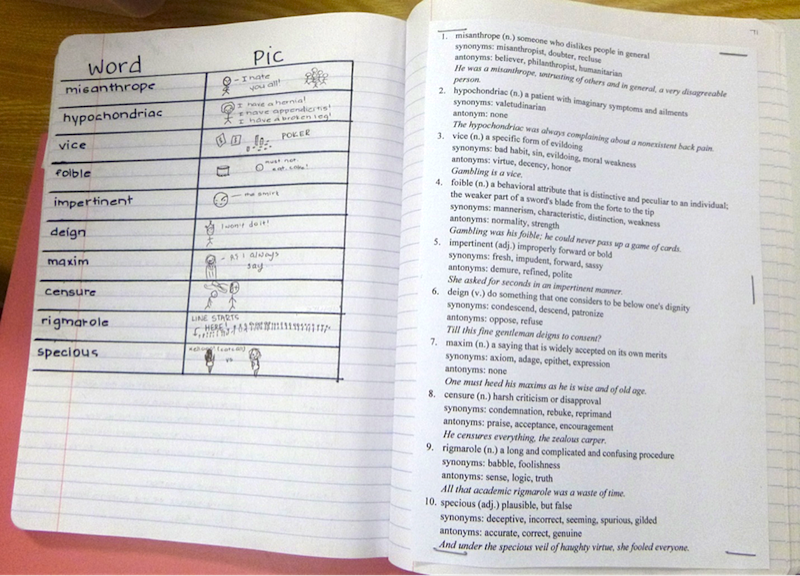
Differentiating llamas – and kids
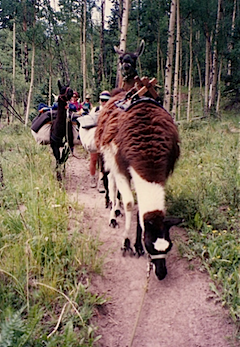
In Joshua’s case, we had to unpack him for a few miles and spread his gear amongst the others. For students in class, it would be a waste of instructional time to have them practice or learn words they already know. Students bring knowledge of different words to our class, which means they need to learn different new words. Giving students choice (within boundaries) helps me differentiate word learning. While there is some overlap in terms of who is learning which words, students can curate different word learning lists online and in their journals.
Vocabulary.com allows users to create individualized lists, and then practice with the lists to learn new words. Embedded into the site are example sentences or word usage, drawn from a variety of articles. Practice includes multiple-choice and fill in the blank quiz-show style questions.
I am suspect of points, rewards and badges, but students’ reactions surprise me. Just yesterday Kanwal said the badges made her want to keep playing. She’d racked up more than thirty thousand points, playing on her own, as she reviewed words this quarter.
Following the signals
When you are hiking through the wilderness, success depends on paying attention to signs that predict the weather or mark the best trail. In the classroom, quality research signals effective practice. When it comes to developing students’ word knowledge, Isabel Beck, Margaret McKeown, and Linda Kucan (Bringing Words to Life, 2002/2013) recommend fortifying students’ understanding of words with explanations and examples—a fuller context than mere definitions provide. Vocabulary.com connects teachers to rich contexts: audio, articles and examples sentences from literature. And Educreations, a free app, helps me build even more.
Like llamas, students need a leader. Without a leader, the herd will wander off or lose focus on the trail. As the lead learner in class, I use Educreations (“teach what you know; learn what you don’t”) to explicitly teach words. I like that the tool enables me to save and publish the teaching in a short video posted online. Students can come back to the words at anytime.
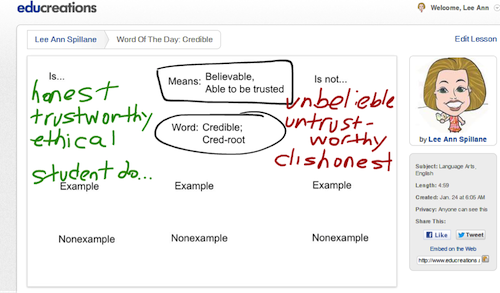
Self-sufficient creatures
On the trail, llamas are relatively self-sufficient. Ruminants don’t eat much, so staking them out along the way for a snack or a break works. When students play review games in class to learn, they feel as if they are taking a break from instruction. Little do they know I’ve staked them out to learn together.
We understand, of course, that students often learn as they play. My students like Quizlet’s word play options. On Quizlet, they can scroll through flashcard stacks, play Scatter and Space Race games or even test themselves. With so many applications and study means to choose from, they stay engaged. Watching them motivate each other and work as a team to beat a game or rack up rounds is always a delight.
“Come on! A minute thirty. Let’s beat that time—we can go faster than that!” Peter urges his group. “The next word is meticulous . . . .”
“Details, think details,” Latranee answers.
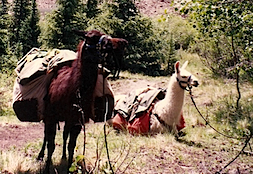
Only once, when Cloud (the white llama pictured in the kush position) had eaten from another’s trough in the barn, did I see the herd actually make good on the spitting threat. Most of the time, as we made our way up country, the llamas encouraged each other with hums and huffs.
When students learn in community, they mostly encourage each other too. During word study in class, students will gather around a device or computer and “play” with words. They remind me of llamas, who like to imitate each other, rolling in the dust pile or rubbing against the same tree on the trail. Herd rituals.
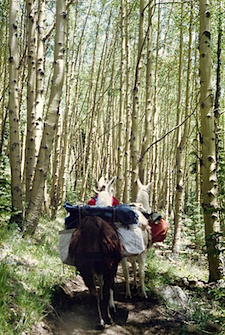
This past week saw many students practicing spelling, a question type on Vocabulary.com. The question has students read a sentence with the word missing, then listen to the word and then spell it in a text box. For a full 10 minutes, groups of students encouraged each other and verbalized the words and their understandings.
Students do that playing Quizlet games too. They operate like a herd on the trail or a study group might in college: one student starts, the others follow. Like Buffalo Bill, they can’t resist the call of the trail—the trail that leads to learning, that is.
This article on is adapted from Lee Ann Spillane’s online interactive book, Reading Amplified: Digital Tools that Engage Students in Words, Books and Ideas (Stenhouse, 2012). See our review here.
_________
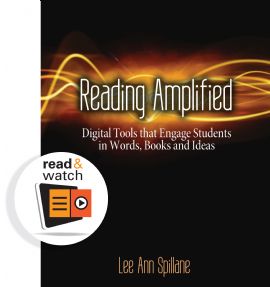
Lee Ann is a National Board Certified Teacher and also worked as a co-writer and senior developer on Janet Allen’s Plugged-In to Reading program published by Recorded Books. Visit Lee Ann’s virtual classroom online here.
































